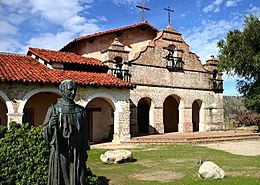Jolon, California facts for kids
Quick facts for kids
Jolon
|
|
|---|---|
| Country | United States |
| State | California |
| County | Monterey County |
| Elevation | 971 ft (296 m) |
Jolon is a small village in southern California, in a place called Monterey County. It's located in the San Antonio River Valley. A big army base, Fort Hunter Liggett, completely surrounds Jolon.
The story of Jolon began in 1771. That's when the Spanish built Mission San Antonio de Padua there. The town itself was officially started in 1849. A man named Antonio Ramírez built an inn, which was a popular stop along an old road called El Camino Real.
Contents
History of Jolon
The area where Jolon is now was once home to the Salinan people. They are one of the many groups of Indigenous Californians.
Spanish Times
In 1769, a famous Spanish group called the Portolá expedition camped near Jolon. They were exploring California. Two years later, in 1771, Junípero Serra started Mission San Antonio de Padua. This mission was part of a system of Spanish missions in California.
Later, the Spanish government decided to take back the mission lands. These lands were supposed to go to the native people. But this rarely happened. Instead, the mission lands around Jolon were divided into several large ranches.
Mexican Times
In 1833, a new law from Mexico greatly changed the missions. The number of people living at Mission San Antonio de Padua dropped a lot. Because of this, the mission area became almost empty. Unlike other missions, it didn't grow into a town during the Spanish or Mexican periods.
In 1845, the governor of California tried to sell all the mission buildings. But no one wanted to buy Mission San Antonio.
American Times
The town of Jolon was truly founded in 1850. That's when Antonio Ramírez built his inn. This inn later became a very important stop for stagecoaches. These coaches carried travelers between San Francisco and Los Angeles.
The inn changed owners several times. In 1876, Lt. George Hough Dutton bought it. He added more to the building, and it became known as the Dutton Hotel. This hotel is now a historic landmark. In 1890, a friend of Dutton's, Captain Thomas Theodore Tidball, opened the Tidball Store nearby. This store is also a historic landmark.
In the early 1920s, a very rich man named William Randolph Hearst bought a lot of land in the area. He owned a famous castle called Hearst Castle. He wanted a ranch headquarters for his new land. So, he hired a famous architect, Julia Morgan, to design a large ranch house. This building was called the Hacienda Milpitas Ranchhouse, or simply "The Hacienda."
Hearst sold his ranch to the U.S. Army in 1940. The army then created Fort Hunter Liggett. This base became an important training center during World War II and is still used today.
Geography and Climate
Jolon is located in the San Antonio River Valley. This is in the southern part of Monterey County, which is on California's Central Coast.
Jolon's Climate
Jolon has a climate where summers are warm and dry. The average temperature in the warmest month is not super hot. This type of weather is called a "warm-summer Mediterranean climate."
| Climate data for Jolon | |||||||||||||
|---|---|---|---|---|---|---|---|---|---|---|---|---|---|
| Month | Jan | Feb | Mar | Apr | May | Jun | Jul | Aug | Sep | Oct | Nov | Dec | Year |
| Mean daily maximum °F (°C) | 63.2 (17.3) |
66.2 (19.0) |
68.9 (20.5) |
74.8 (23.8) |
78.4 (25.8) |
83.0 (28.3) |
85.1 (29.5) |
85.2 (29.6) |
85.0 (29.4) |
79.9 (26.6) |
69.4 (20.8) |
63.2 (17.3) |
75.2 (24.0) |
| Daily mean °F (°C) | 50.2 (10.1) |
53.3 (11.8) |
55.5 (13.1) |
59.0 (15.0) |
62.7 (17.1) |
66.6 (19.2) |
69.0 (20.6) |
68.1 (20.1) |
68.8 (20.4) |
63.2 (17.3) |
54.8 (12.7) |
49.7 (9.8) |
60.1 (15.6) |
| Mean daily minimum °F (°C) | 37.2 (2.9) |
40.3 (4.6) |
42.1 (5.6) |
43.1 (6.2) |
46.9 (8.3) |
50.2 (10.1) |
52.9 (11.6) |
53.1 (11.7) |
51.2 (10.7) |
46.5 (8.1) |
40.1 (4.5) |
36.1 (2.3) |
45.0 (7.2) |
| Average rainfall inches (mm) | 2.35 (60) |
2.65 (67) |
2.49 (63) |
0.74 (19) |
0.24 (6.1) |
0.07 (1.8) |
0.01 (0.25) |
0.05 (1.3) |
0.25 (6.4) |
0.55 (14) |
1.23 (31) |
1.67 (42) |
12.30 (312) |
| Mean daily sunshine hours | 10.5 | 11.4 | 12.4 | 13.6 | 14.6 | 15.1 | 14.8 | 13.9 | 12.8 | 11.7 | 10.7 | 10.2 | 12.6 |
| Source 1: Weather For You | |||||||||||||
| Source 2: Weatherbase | |||||||||||||
Jolon in Books and Songs
Jolon is mentioned in a folk song called "South Coast." The song was made popular by the Kingston Trio in 1959. It talks about Jolon as a place where people used to gamble a long time ago.
Jolon is also the setting for a book by John Steinbeck called To a God Unknown. The town itself isn't named in the book, but it's the place the story is based on.
Images for kids
-
Mission San Antonio de Padua in 1873.
-
Hacienda Milpitas was designed by Julia Morgan.
-
Mission San Antonio de Padua in 2020.
-
The Hacienda Hotel is inside Fort Hunter Liggett.










